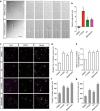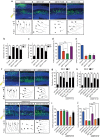Discovery of long-range inhibitory signaling to ensure single axon formation
- PMID: 28652571
- PMCID: PMC5484694
- DOI: 10.1038/s41467-017-00044-2
Discovery of long-range inhibitory signaling to ensure single axon formation
Abstract
A long-standing question in neurodevelopment is how neurons develop a single axon and multiple dendrites from common immature neurites. Long-range inhibitory signaling from the growing axon is hypothesized to prevent outgrowth of other immature neurites and to differentiate them into dendrites, but the existence and nature of this inhibitory signaling remains unknown. Here, we demonstrate that axonal growth triggered by neurotrophin-3 remotely inhibits neurite outgrowth through long-range Ca2+ waves, which are delivered from the growing axon to the cell body. These Ca2+ waves increase RhoA activity in the cell body through calcium/calmodulin-dependent protein kinase I. Optogenetic control of Rho-kinase combined with computational modeling reveals that active Rho-kinase diffuses to growing other immature neurites and inhibits their outgrowth. Mechanistically, calmodulin-dependent protein kinase I phosphorylates a RhoA-specific GEF, GEF-H1, whose phosphorylation enhances its GEF activity. Thus, our results reveal that long-range inhibitory signaling mediated by Ca2+ wave is responsible for neuronal polarization.Emerging evidence suggests that gut microbiota influences immune function in the brain and may play a role in neurological diseases. Here, the authors offer in vivo evidence from a Drosophila model that supports a role for gut microbiota in modulating the progression of Alzheimer's disease.
Conflict of interest statement
The authors declare no competing financial interests.
Figures








Similar articles
-
Local application of neurotrophins specifies axons through inositol 1,4,5-trisphosphate, calcium, and Ca2+/calmodulin-dependent protein kinases.Sci Signal. 2011 Nov 15;4(199):ra76. doi: 10.1126/scisignal.2002011. Sci Signal. 2011. PMID: 22087032
-
LRRK2 guides the actin cytoskeleton at growth cones together with ARHGEF7 and Tropomyosin 4.Biochim Biophys Acta. 2013 Dec;1832(12):2352-67. doi: 10.1016/j.bbadis.2013.09.009. Epub 2013 Sep 24. Biochim Biophys Acta. 2013. PMID: 24075941
-
Signaling pathways that control rho kinase activity maintain the embryonic epicardial progenitor state.J Biol Chem. 2015 Apr 17;290(16):10353-67. doi: 10.1074/jbc.M114.613190. Epub 2015 Mar 2. J Biol Chem. 2015. PMID: 25733666 Free PMC article.
-
CaMKK-CaMKI signaling pathways differentially control axon and dendrite elongation in cortical neurons.J Neurosci. 2010 Feb 24;30(8):2807-9. doi: 10.1523/JNEUROSCI.5984-09.2010. J Neurosci. 2010. PMID: 20181577 Free PMC article. Review. No abstract available.
-
Key regulators in neuronal polarity.Neuron. 2005 Dec 22;48(6):881-4. doi: 10.1016/j.neuron.2005.11.007. Neuron. 2005. PMID: 16364893 Review.
Cited by
-
CH(II), a cerebroprotein hydrolysate, exhibits potential neuro-protective effect on Alzheimer's disease.PLoS One. 2019 Sep 23;14(9):e0222757. doi: 10.1371/journal.pone.0222757. eCollection 2019. PLoS One. 2019. PMID: 31545823 Free PMC article.
-
Neurotoxicity of the pesticide rotenone on neuronal polarization: a mechanistic approach.Neural Regen Res. 2019 May;14(5):762-766. doi: 10.4103/1673-5374.249847. Neural Regen Res. 2019. PMID: 30688258 Free PMC article. Review.
-
Rho-Rho-Kinase Regulates Ras-ERK Signaling Through SynGAP1 for Dendritic Spine Morphology.Neurochem Res. 2022 Sep;47(9):2757-2772. doi: 10.1007/s11064-022-03623-y. Epub 2022 May 27. Neurochem Res. 2022. PMID: 35624196
-
Calpain activation and disturbance of autophagy are induced in cortical neurons in vitro by exposure to HA/β-Ga2O3:Cr3+ nanoparticles.PeerJ. 2018 Feb 7;6:e4365. doi: 10.7717/peerj.4365. eCollection 2018. PeerJ. 2018. PMID: 29441243 Free PMC article.
-
Structural Analysis of Inhibitor Binding to CAMKK1 Identifies Features Necessary for Design of Specific Inhibitors.Sci Rep. 2018 Oct 4;8(1):14800. doi: 10.1038/s41598-018-33043-4. Sci Rep. 2018. PMID: 30287839 Free PMC article.
References
Publication types
MeSH terms
Substances
Grants and funding
LinkOut - more resources
Full Text Sources
Other Literature Sources
Molecular Biology Databases
Research Materials
Miscellaneous

